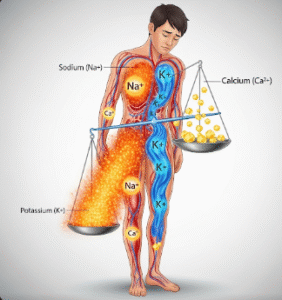Overview
Low hemoglobin, also called anemia, occurs when the concentration of hemoglobin in the blood drops below normal levels. Hemoglobin is the protein in red blood cells responsible for carrying oxygen from the lungs to tissues. Low hemoglobin reduces oxygen delivery, leading to fatigue, weakness, and organ stress.
In Korea, hematology and general medicine clinics provide advanced diagnostic testing, including complete blood counts, iron studies, vitamin assessments, and bone marrow analysis, to determine the underlying cause of anemia. Early diagnosis and treatment are essential to prevent complications such as heart strain, cognitive difficulties, and reduced quality of life.
Key Facts
- ➔ Hemoglobin levels are normally 13.5–17.5 g/dL for men and 12.0–15.5 g/dL for women, though ranges may vary slightly with age.
- ➔ Low hemoglobin can be temporary, mild, or chronic, depending on its cause.
- ➔ Causes include iron deficiency, vitamin deficiencies, chronic diseases, or blood loss.
- ➔ Common symptoms include fatigue, paleness, shortness of breath, and dizziness.
- ➔ Timely evaluation and treatment can restore hemoglobin levels and prevent organ damage.
What is Low Hemoglobin?
Low hemoglobin, or anemia, is a condition where the blood has insufficient oxygen-carrying capacity:
- ➔ Physiological impact: Reduced hemoglobin leads to less oxygen delivery to tissues, causing fatigue, weakness, and poor exercise tolerance.
- ➔ Severity levels: Mild, moderate, and severe anemia are classified based on hemoglobin concentration.
- ➔ Clinical importance: Chronic low hemoglobin can lead to cardiovascular strain, cognitive difficulties, and compromised immunity.
- ➔ Detection: Diagnosed with complete blood count (CBC) tests, reticulocyte counts, and iron studies.
What Symptoms Are Related To
Low hemoglobin may present with various symptoms depending on severity:
- ➔ Fatigue, lethargy, or generalized weakness
- ➔ Pale skin or mucous membranes
- ➔ Shortness of breath, especially during exertion
- ➔ Dizziness, lightheadedness, or fainting
- ➔ Rapid or irregular heartbeat (palpitations)
- ➔ Cold hands and feet
- ➔ Headaches or difficulty concentrating
- ➔ Brittle nails or hair loss in some cases
These symptoms often prompt medical evaluation and help identify the underlying cause of anemia.
What Causes / Possible Causes
Low hemoglobin can result from multiple conditions:
- ➔ Iron deficiency: Most common cause due to insufficient dietary intake, poor absorption, or chronic blood loss (e.g., heavy menstruation).
- ➔ Vitamin deficiencies: Lack of vitamin B12 or folate affects red blood cell production.
- ➔ Chronic diseases: Kidney disease, autoimmune conditions, or cancer may suppress hemoglobin production.
- ➔ Blood loss: Trauma, surgery, or gastrointestinal bleeding can reduce hemoglobin.
- ➔ Genetic disorders: Conditions like thalassemia or sickle cell anemia.
- ➔ Bone marrow disorders: Aplastic anemia or leukemia affecting red blood cell production.
- ➔ Medications: Certain drugs can impair red blood cell production or cause hemolysis.
Accurate diagnosis is crucial to address the underlying cause and restore hemoglobin levels safely.
When Should I See My Doctor
Medical evaluation is necessary if low hemoglobin is:
- ➔ Persistent or worsening fatigue, weakness, or paleness
- ➔ Accompanied by shortness of breath, chest pain, or rapid heartbeat
- ➔ Associated with unexplained bruising, bleeding, or frequent infections
- ➔ Occurring alongside weight loss or gastrointestinal symptoms
- ➔ Detected incidentally on a blood test with no clear cause
Early consultation with a hematologist or primary care physician helps determine the cause and prevents complications.
Care and Treatment
Treatment for low hemoglobin focuses on restoring red blood cell levels and addressing the underlying cause:
- ➔ Iron deficiency anemia: Oral or intravenous iron supplementation and dietary adjustments.
- ➔ Vitamin deficiency anemia: Vitamin B12 injections or oral folate supplements.
- ➔ Chronic disease anemia: Treating the underlying condition and supportive therapies.
- ➔ Blood loss: Stopping the source of bleeding, surgery if necessary, and blood transfusions in severe cases.
- ➔ Genetic or bone marrow disorders: Specialized therapies, including bone marrow transplantation or disease-modifying medications.
- ➔ Lifestyle support: Adequate nutrition, rest, and avoidance of activities that exacerbate fatigue.
With proper treatment, hemoglobin levels can return to normal, improving energy, organ function, and overall well-being.
Treatment Options in Korea
Korean hospitals provide comprehensive care for low hemoglobin:
- ➔ Laboratory diagnostics: Complete blood counts, iron panels, vitamin assays, and bone marrow studies.
- ➔ Imaging studies: Endoscopy or ultrasonography to identify sources of blood loss.
- ➔ Medical therapy: Iron supplementation, vitamin therapy, erythropoiesis-stimulating agents, or immunosuppressive treatments.
- ➔ Blood transfusions: For severe anemia requiring rapid restoration of hemoglobin.
- ➔ Surgical interventions: Treatment of bleeding sources such as ulcers or tumors.
- ➔ Multidisciplinary approach: Collaboration between hematologists, gastroenterologists, nutritionists, and primary care providers for personalized treatment plans.
Top hospitals such as Seoul National University Hospital, Samsung Medical Center, and Asan Medical Center provide advanced diagnostic and treatment options, ensuring early detection, safe management, and effective recovery of hemoglobin levels.
In Summary: Low hemoglobin is a common and potentially serious condition that can lead to fatigue, cardiovascular stress, and organ compromise. Early evaluation and treatment in Korea can restore hemoglobin, improve energy levels, and prevent complications.
- ➔ Key Takeaway: Persistent fatigue, weakness, or paleness may indicate low hemoglobin and should be medically evaluated.
- ➔ Action Point: Consult a physician for laboratory testing, diagnosis, and individualized treatment to restore hemoglobin safely.













